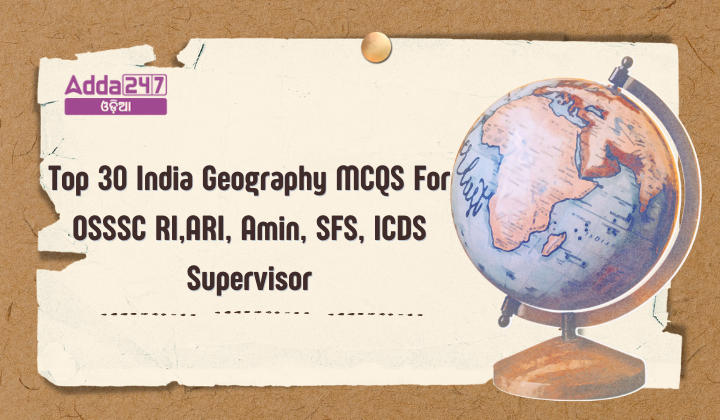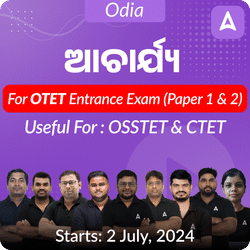Geography plays a crucial role in various competitive exams, including OSSSC RI, ARI, AMIN, SFS, and ICDS Supervisor. To assist candidates in their preparation, we have compiled a set of 30 Multiple Choice Questions (MCQs) at a moderate difficulty level. Each question is accompanied by a correct answer to enhance your geographical knowledge and better prepare you for the upcoming exams.
Top 30 India Geography MCQs For OSSSC RI,ARI, Amin, SFS, ICDS Supervisor
- When was the idea of cleaning the Ganga river initiated by the Government of India?
(a) 1986
(b) 1979
(c) 1985
(d) 1993
Answer: (b) 1979 - Who directed the Ganga Action Plan when it was launched?
(a) Indira Gandhi
(b) Rajiv Gandhi
(c) Arun Jaitley
(d) Narendra Modi
Answer: (b) Rajiv Gandhi - Which authority was established under the Ganga Action Plan to oversee its implementation?
(a) Central Pollution Control Board
(b) National River Conservation Directorate
(c) Central Ganga Authority
(d) National Ganga Council
Answer: (c) Central Ganga Authority - Under which act was the National Mission for Clean Ganga (NMCG) established as a registered society?
(a) Environment Protection Act, 1986
(b) Societies Registration Act, 1860
(c) Water (Prevention and Control of Pollution) Act, 1974
(d) Wildlife Protection Act, 1972
Answer: (b) Societies Registration Act, 1860 - What was the primary objective of the Ganga Action Plan when it was launched in 1985?
(a) Increase fish population in Ganga
(b) Improve the water quality of Ganga to acceptable standards
(c) Promote tourism along Ganga
(d) Build dams on the Ganga
Answer: (b) Improve the water quality of Ganga to acceptable standards - Which of the following is an example of an exogenic geomorphic process?
(a) Volcanism
(b) Diastrophism
(c) Erosion
(d) Earthquake
Ans. (c) Erosion - The process by which the earth’s surface is reshaped through rock movements and displacement is termed as:
(a) Weathering
(b) Erosion
(c) Diastrophism
(d) Deposition
Ans. (c) Diastrophism - What is the main source of energy responsible for endogenic geomorphic processes?
(a) Solar energy
(b) Wind energy
(c) Radioactivity
(d) Ocean currents
Ans. (c) Radioactivity - Which of the following processes is not included under mass wasting?
(a) Rock falls
(b) Rock slides
(c) Frost wedging
(d) Slump
Ans. (c) Frost wedging - The alternate expansion and contraction of minerals in the rocks due to temperature variations lead to:
(a) Carbonation
(b) Oxidation
(c) Granular disintegration
(d) Hydration
Ans. (c) Granular disintegration - Which geomorphic agent is most responsible for the formation of caves?
(a) Wind
(b) Running water
(c) Ocean currents
(d) Glaciers
Ans. (b) Running water - What is the primary driver behind exogenic geomorphic processes like weathering and erosion?
(a) Internal heat of the Earth
(b) Gravitational stresses
(c) Biological activities
(d) Human activities
Ans. (b) Gravitational stresses - The formation of a dome-shaped monolith through the breaking away of curved layers of rock is known as:
(a) Frost wedging
(b) Block disintegration
(c) Exfoliation
(d) Solution
Ans. (c) Exfoliation - Which of the following factors is not directly involved in soil formation?
(a) Parent material
(b) Topography
(c) Ocean currents
(d) Climate
Ans. (c) Ocean currents - What type of weathering occurs when oxygen combines with water and iron, causing rock disintegration?
(a) Hydrolysis
(b) Carbonation
(c) Oxidation
(d) Hydration
Ans. (c) Oxidation - Which of the following river systems is the longest in India?
(a) Indus River System
(b) Ganga River System
(c) Brahmaputra River System
(d) Yamuna River System
Ans. (a) Indus River System - What is the length of the Brahmaputra River System within India?
(a) 2900 km
(b) 1114 km
(c) 916 km
(d) 2510 km
Ans. (c) 916 km - Which river system has a total length equal to its length within India?
(a) Ganga River System
(b) Yamuna River System
(c) Narmada River System
(d) Tapi River System
Ans. (a) Ganga River System - The Yamuna River System is a major tributary of which river?
(a) Brahmaputra River System
(b) Godavari River System
(c) Indus River System
(d) Ganga River System
Ans. (d) Ganga River System - What is the total length of the Narmada River System?
(a) 1376 km
(b) 1312 km
(c) 1400 km
(d) 1465 km
Ans. (b) 1312 km - The Tapi River System flows through which of the following states?
(a) Madhya Pradesh, Gujarat, and Maharashtra
(b) Uttar Pradesh and Bihar
(c) Karnataka and Tamil Nadu
(d) Punjab and Haryana
Ans. (a) Madhya Pradesh, Gujarat, and Maharashtra - The Godavari River System is often referred to as the ‘Dakshina Ganga’. What is its length?
(a) 724 km
(b) 1400 km
(c) 805 km
(d) 1465 km
Ans. (d) 1465 km - Which of the following river systems is the shortest in length?
(a) Krishna River System
(b) Cauvery River System
(c) Mahanadi River System
(d) Tapi River System
Ans. (d) Tapi River System - The Krishna River System is crucial for which two Indian states?
(a) Andhra Pradesh and Telangana
(b) Maharashtra and Gujarat
(c) Tamil Nadu and Kerala
(d) Karnataka and Andhra Pradesh
Ans. (d) Karnataka and Andhra Pradesh - What is the length of the Cauvery River System within India?
(a) 851 km
(b) 805 km
(c) 724 km
(d) 1376 km
Ans. (b) 805 km - What is the definition of climate change?
(a) The periodic modification of Earth’s climate due to interactions between the atmosphere and geological factors.
(b) Sudden changes in weather patterns caused by human activities.
(c) The seasonal variation in temperature and precipitation.
(d) A phenomenon exclusive to tropical regions.
Answer: (a) The periodic modification of Earth’s climate due to interactions between the atmosphere and geological factors. - Which of the following is NOT a natural factor affecting climate change?
(a) Continental Drift
(b) Volcanism
(c) Changes in Earth’s Orbit
(d) Greenhouse Gas emissions
Answer: (d) Greenhouse Gas emissions - How does volcanic activity influence climate change?
(a) By emitting greenhouse gases that trap heat in the atmosphere.
(b) By releasing aerosols that reflect sunlight, cooling the Earth.
(c) By causing deforestation and land use changes.
(d) By increasing global ocean temperatures.
Answer: (b) By releasing aerosols that reflect sunlight, cooling the Earth. - What is the primary cause of anthropogenic climate change?
(a) Changes in Earth’s Orbit
(b) Solar radiation management
(c) Greenhouse gas emissions
(d) Continental drift
Answer: (c) Greenhouse gas emissions - How does a shift in land-use pattern contribute to climate change?
(a) By reducing solar energy absorption.
(b) By increasing forest cover.
(c) By reducing aerosol emissions.
(d) By increasing solar energy absorption and altering atmospheric moisture levels.
Answer: (d) By increasing solar energy absorption and altering atmospheric moisture levels.





